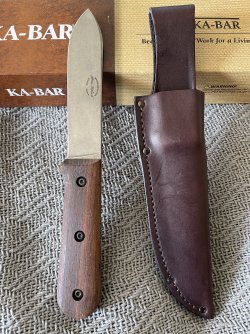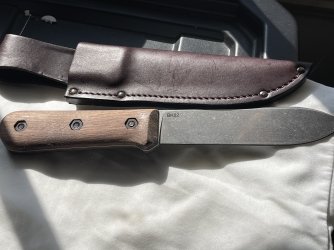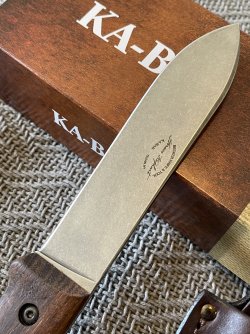TidalWave
Professional
Wasn’t sure whether to post here or the Gear thread, but anywho…
Kabar bk62 (Kephart)
My new knife, sort of a cross between a minimalist survival knife and a basic camp/ outdoors generalist blade. Whichever, whatever, I think it rocks.
Horace Kephart, some sort of earlier 1900s NE woodsman apparently designed it. Also authored at least 1 outdoors book.
Full tang for strength, blade length 5” & handle 4.5” (actual grippy part ~4.25”)…. Appears very good edge for production knife - but we’ll have to see.
Straightforward functional shape, although no crossguard makes this lean rather more to utility than SD (other than last resort). I’ve always said 6” min is my standard for a sheath knife, but must say this one seems more than useful. Wide blade will take on a patina with use, but if it’ll polish to ‘like new’ it can flash a sunlight reflection for signaling easily.
Pics below, even paired with my SS springer Garrison .45, and my good ol’ Rothco tactical fleece jacket (part of my back of the SUV layering gear). gear).
gear).


Kabar bk62 (Kephart)
My new knife, sort of a cross between a minimalist survival knife and a basic camp/ outdoors generalist blade. Whichever, whatever, I think it rocks.
Horace Kephart, some sort of earlier 1900s NE woodsman apparently designed it. Also authored at least 1 outdoors book.
Full tang for strength, blade length 5” & handle 4.5” (actual grippy part ~4.25”)…. Appears very good edge for production knife - but we’ll have to see.
Straightforward functional shape, although no crossguard makes this lean rather more to utility than SD (other than last resort). I’ve always said 6” min is my standard for a sheath knife, but must say this one seems more than useful. Wide blade will take on a patina with use, but if it’ll polish to ‘like new’ it can flash a sunlight reflection for signaling easily.
Pics below, even paired with my SS springer Garrison .45, and my good ol’ Rothco tactical fleece jacket (part of my back of the SUV layering gear).
 gear).
gear).





